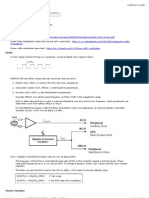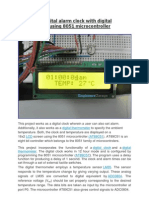Pseudo Code
Uploaded by
aligstanleyPseudo Code
Uploaded by
aligstanleyFiles
Functions
Description
Timer.c
count_down(run_timer)
This function will initialize Timer1 and count up to 1 second. A logic
will use the variable pause_timer to enable or disable the interrupt. If run_timer
= 1, run, if run_timer = 0, disable. interruptEN = run_timer;
delay_ms(delay)
This function will initialize Timer2 and trigger ISR when it reaches
delay. It will be used to generate the PWM.
Timer1 ISR
The ISR toggles the LED_on and decrements the global variable
timer_set_value by 1. If timer_set_value reaches 0 it sets a flag
count_down_finish.
Timer2 ISR
The ISR sets the flag back to 0.
UART.c
display_time(timer_set_value, display_mode)
This function will display the time in the format m:ss based on the
current value of timer_set_value (which is in seconds). If display_mode = 0, show
only time, if display_mode = 1, show ADC reading and LED intensity setting as well.
get_time_input(enable_input)
If enable_input = 1, this function will get three user character inputs
(only numbers) in the format m:ss and when it gets all three numbers it sets
timer_set_value to the time in seconds, sets enable_input to 0 and returns.
set_display_mode(display_mode)
If user presses 'i' toggle display_mode.
LED.c
initialize()
read_ADC(ADC_value)
Reads the value at the potentiometer and stores it in global variable
ADC_value.
duty_cycle_set(pulse, ADC_value, duty_cycle)
If in pulse = 0, sets the PWM Duty cycle based on the ADC_value.
If in pulse = 1, sets the PWM Duty cycle to add 1 to duty_cycle every
100ms using Delay_ms(100) until it reaches 100 and decreases until it reaches 0.
LED_control(duty_cycle, LED_on)
If LED_on = 1, use delay_ms(duty_cycle*period/100) and delay_ms(period
- duty_cycle*period/100) to toggle the LED. If LED_on = 0, LED is off.
You might also like
- CS 241 System Programming: Timers & SignalsNo ratings yetCS 241 System Programming: Timers & Signals23 pages
- Gas Leakage Detector Using Arduino and GSM Module With SMS Alert and Sound AlarmNo ratings yetGas Leakage Detector Using Arduino and GSM Module With SMS Alert and Sound Alarm5 pages
- Prepaid Energy Meter Using GSM and Arduino: Saddam 93 CommentsNo ratings yetPrepaid Energy Meter Using GSM and Arduino: Saddam 93 Comments16 pages
- Application Note: Document: AN01002 Revision: 0No ratings yetApplication Note: Document: AN01002 Revision: 06 pages
- Prepaid Energy Meter Project Using ArduinoNo ratings yetPrepaid Energy Meter Project Using Arduino18 pages
- Lab#4 Introduction To Timers (Timer ON) : ObjectiveNo ratings yetLab#4 Introduction To Timers (Timer ON) : Objective2 pages
- DC Motor Bidirectional Speed Control Using PWM PDF100% (1)DC Motor Bidirectional Speed Control Using PWM PDF5 pages
- Timeunit and Timeprecision in SystemVerilogNo ratings yetTimeunit and Timeprecision in SystemVerilog3 pages
- Multivariate Multi Step Time Series Forecasting Using Stacked LSTM Sequence To Sequence Autoencoder in Tensorflow 2 0 KerasNo ratings yetMultivariate Multi Step Time Series Forecasting Using Stacked LSTM Sequence To Sequence Autoencoder in Tensorflow 2 0 Keras9 pages
- Computational Robotics Engineering: Timers and InterruptsNo ratings yetComputational Robotics Engineering: Timers and Interrupts8 pages
- 99 000 RPM Contact Less Digital TachometerNo ratings yet99 000 RPM Contact Less Digital Tachometer11 pages
- Microcontroller Tutorial Ii Timers: What Is A Timer?No ratings yetMicrocontroller Tutorial Ii Timers: What Is A Timer?13 pages
- Timers and Counters Instruction PLC Tutorial75% (4)Timers and Counters Instruction PLC Tutorial26 pages
- Introduction To Pic Programming: Programming Baseline Pics in CNo ratings yetIntroduction To Pic Programming: Programming Baseline Pics in C20 pages
- 3 Power LED Dimmer Using ATmega32 MicrocontrollerNo ratings yet3 Power LED Dimmer Using ATmega32 Microcontroller5 pages
- Programmable Timing Functions Part 1: Timer-Generated InterruptsNo ratings yetProgrammable Timing Functions Part 1: Timer-Generated Interrupts25 pages
- PID Controller: Figure 1: A Crude Example For A RegulationNo ratings yetPID Controller: Figure 1: A Crude Example For A Regulation5 pages
- Iii. Programmable Logic Controller (PLC) Omron Cpm1ANo ratings yetIii. Programmable Logic Controller (PLC) Omron Cpm1A17 pages
- Timer Interrupts: Here Arduino Due Forum PostNo ratings yetTimer Interrupts: Here Arduino Due Forum Post7 pages
- GSM Based SMS Alert Fire Alarm System Using ArduinoNo ratings yetGSM Based SMS Alert Fire Alarm System Using Arduino9 pages
- LCD Based Digital Alarm Clock With Digital Thermometer Using 8051 Microcontroller (AT89C51)No ratings yetLCD Based Digital Alarm Clock With Digital Thermometer Using 8051 Microcontroller (AT89C51)16 pages
- Control of DC Motor Using Different Control StrategiesFrom EverandControl of DC Motor Using Different Control StrategiesNo ratings yet



























































